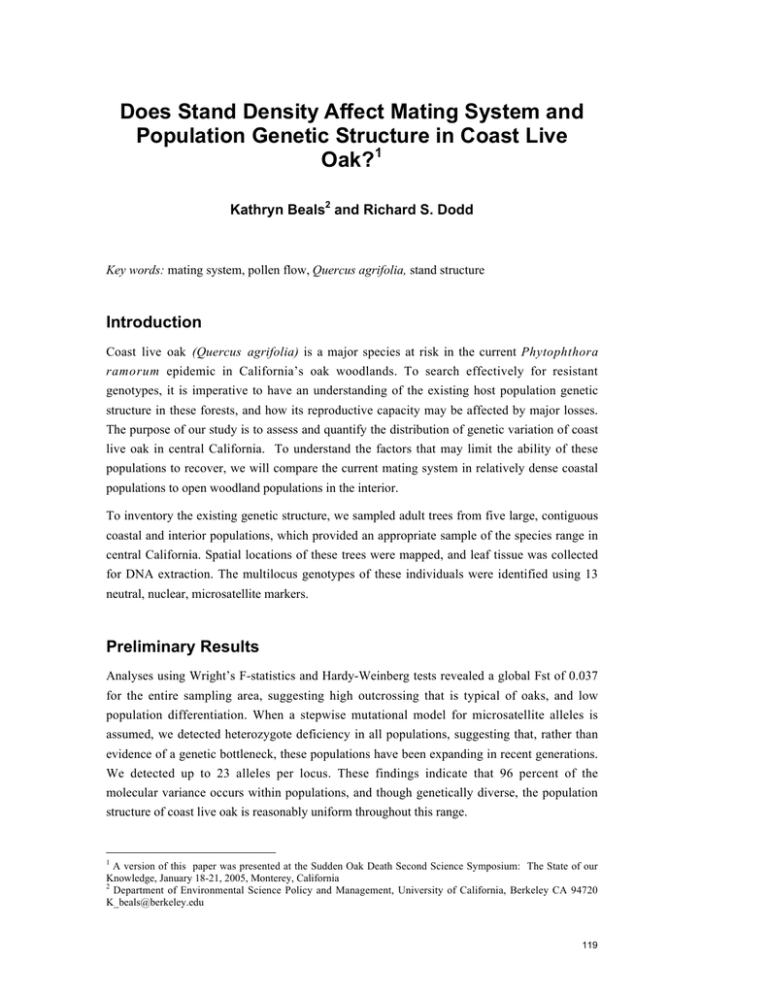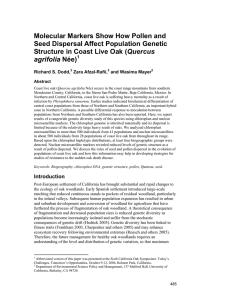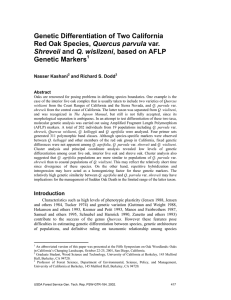Does Stand Density Affect Mating System and Oak? Introduction
advertisement

Does Stand Density Affect Mating System and Population Genetic Structure in Coast Live Oak?1 Kathryn Beals2 and Richard S. Dodd Key words: mating system, pollen flow, Quercus agrifolia, stand structure Introduction Coast live oak (Quercus agrifolia) is a major species at risk in the current Phytophthora ramorum epidemic in California’s oak woodlands. To search effectively for resistant genotypes, it is imperative to have an understanding of the existing host population genetic structure in these forests, and how its reproductive capacity may be affected by major losses. The purpose of our study is to assess and quantify the distribution of genetic variation of coast live oak in central California. To understand the factors that may limit the ability of these populations to recover, we will compare the current mating system in relatively dense coastal populations to open woodland populations in the interior. To inventory the existing genetic structure, we sampled adult trees from five large, contiguous coastal and interior populations, which provided an appropriate sample of the species range in central California. Spatial locations of these trees were mapped, and leaf tissue was collected for DNA extraction. The multilocus genotypes of these individuals were identified using 13 neutral, nuclear, microsatellite markers. Preliminary Results Analyses using Wright’s F-statistics and Hardy-Weinberg tests revealed a global Fst of 0.037 for the entire sampling area, suggesting high outcrossing that is typical of oaks, and low population differentiation. When a stepwise mutational model for microsatellite alleles is assumed, we detected heterozygote deficiency in all populations, suggesting that, rather than evidence of a genetic bottleneck, these populations have been expanding in recent generations. We detected up to 23 alleles per locus. These findings indicate that 96 percent of the molecular variance occurs within populations, and though genetically diverse, the population structure of coast live oak is reasonably uniform throughout this range. 1 A version of this paper was presented at the Sudden Oak Death Second Science Symposium: The State of our Knowledge, January 18-21, 2005, Monterey, California 2 Department of Environmental Science Policy and Management, University of California, Berkeley CA 94720 K_beals@berkeley.edu 119 GENERAL TECHNICAL REPORT PSW-GTR-196 Wright’s Fis estimates of single-population inbreeding revealed small, but statistically significant, differences between the coastal and interior regions that were sampled. Coastal populations, where stand structure is denser and contains a mixture of species, had higher rates of inbreeding than the interior populations. The interior populations, which exhibit higher outcrossing, are close to the limit of the species range and may be benefiting from more open pollen flow. Current Research The second part of our study addresses the most recent mating between the adult trees in these populations. We have collected acorns from the adult study trees in the fall of 2004 and are using the same 13 markers to determine their paternity. From these data we will estimate the proportion of effective pollen donors in each population. Incorporating the spatial locations of the parent trees, we will estimate the average distance of successful pollen dispersal within a stand. This information will indicate the success of the current mating, and the ability of these stands to recover their reproductive capacity after a reduction in their effective population size. To follow the movement of genes via seed, we are genotyping these adult trees using five maternally inherited chloroplast primers. This will allow us to gauge the component of gene flow that has resulted from the distribution of acorns, in addition to what we know about gene flow via pollen. Conclusions From the preliminary results of this study, we conclude that coast live oak has low differentiation in population genetic structure throughout central California. A vast majority of the genetic variation in this species is contained at the population level, so searches for resistant genotypes could be limited to smaller areas of the species distribution. Coastal populations exhibit more inbreeding than interior populations, which may be a result of their dense, mixed species stand structure. Pollen flow may be less restricted in open woodland interior populations, resulting in greater outcrossing. Current research will provide more insight into pollen movement in these two stand types, and the contribution that maternal seed distribution makes towards gene flow in this species. Evaluating the current mating system of coast live oak during the Phytophthora outbreak will help to predict the impact of adult tree mortality on the future genetic diversity of these populations, and allow better allocation of conservation resources. 120 Proceedings of the sudden oak death second science symposium: the state of our knowledge 121








